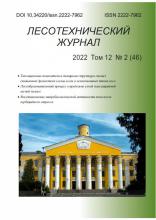Mytischi, Moscow, Russian Federation
Mytischi, Moscow, Russian Federation
Heat treatment is widely used to improve the properties of wood. Such processes include drying and thermal modification. Thermal modification is heating wood without oxygen, accompanied by heat destruction. Thermally modified wood can be used as structural and finishing materials. This puts the task of determining its thermal and physical, physical and chemical, biological, and ornamental properties and their change during heat treatment. The article presents the results of experimental and computational studies of color characteristics of the wood of birch, their change in the process of thermal modification. Thermal decomposition is a complicated multi-stage physical and chemical process. Thermal decomposition of material causes changes in its composition, structure, accompanied by alterations of its properties. Wood can be considered as a multicomponent composite material, consisting of hemicellulose, cellulose, lignin and other components. Each component decomposes in the temperature range that causes the multistage process of thermal degradation. The degree of thermal degradation of the material is determined by the kinetics of occurrence of each stage and the degree of its perfection. Thermal decomposition kinetics of wood can be determined by the results of thermal and gravimetric experiments. In the article the model of determining the color characteristics of wood as a function of the degree of completion of individual stages of thermal degradation is suggested. Model of decomposition of color for RGB components is used for identifying. Color identification of the samples of original birch wood in RGB coordinates was performed. The parameters of thermal effects, allowing to obtain wood with given degree of thermal decomposition are defined. Heat treatment of samples and identification of their color is made. The dependence of RGB parameters from time and intensity of heat treatment is studied. Empirical relations to determine the identifying characteristics of color, as a function of the degree of completion of stages of thermal destruction, in RGB and LAB systems are obtained in explicit form.
wood, thermal modification, identification of color, color characteristics, kinetic parameters.
Для улучшения свойств древесины широко используется ее термическая обработка, одним из видов которой является термическое модифицирование. Термомодифицирование – это нагрев древесины без доступа кислорода, сопровождающийся ее термической деструкцией. Термически модифицированная древесина может использоваться в качестве конструкционных и отделочных материалов. Это ставит задачу определения ее теплофизических, физико-химических, биологических и декоративных свойств, а также их изменения при термической обработке.
1. Ermochenkov M. G. Prognozirovanie svoystv termicheski modifitsirovannoy drevesiny [Predicting the properties of thermally modified wood]. Moscow State Forest University Bulletin - Lesnoi Vestnik, 2010, № 4 (73), pp.111-115.
2. Zhigunov S.V. Teplomassoobmen i kinetika termodestruktsyi pri vysokotemperaturnom nagreve kompozitsionnyh materialov [Heat and mass transfer and kinetics of thermal degradation at high temperature composite materials] diss. … kand. tekhn. nauk [.dis. ... Cand. tehn. sciences]. Moscow, 1990.
3. Kislitsin A.N. Piroliz drevesiny: himizm, kinetika, produkty, novye protsessy [Pyrolysis of Wood: chemistry, kinetics, products, new processes]. Moscow: Lesnaya promyshlennost [Forest Industry], 1990, 312 p.
4. Kuvik T.E. Kinetika termicheskoy destruktsyi drevesiny v prilozhenii k prognozirovaniyu svoystv termomodifitsirovannoy drevesiny [Kinetics of thermal degradation of wood in the annex to predict the properties of wood thermomodified]. 4 Mezhdunarodnaya nauchno-prakticheskaya konferentsiya “Sovremennye energosberegaushye teplovye tehnologii (sushka i termovlazhnostnaya obrabotka materialov) SETT” [The Fourth International scientific-practical conference "Modern energy-saving heat technology (drying and hydrothermal treatment of materials) SETT”]. Moscow, 2011. T.2, pp. 144-148.
5. Shvedov B.A. Energo- i massoobmen v materialah teplovoy zashity mnogorazovyh raketno-kosmicheskih system: [Energy and mass transfer in thermal protection materials reusable space-rocket systems]: diss. … doct. Tekhn. Nauk [diss. ... Doctor. tehn. sciences]. Moscow, 1990.
6. Bekhta P, Niemz P (2003): Effect of high temperature on the changes in colour, dimensional stability and mechanical properties of spruce wood. Holzforsch, 57, (5), s. 539-546.
7. Calonego WF, Durgante Severe ET, Furtado EL (2010) Decay resistance of thermally-modified Eucalyptus grandis wood at 140°C, 160°C, 180°C, 200°C and 220°C. Bioresour Technol 101:9391-9394
8. Esteves B, Pereira H (2009) Wood modification by heat treatment: a review. Bioresources 4(l):370-404
9. Slopiecka, Katarzyna; Bartocci, Pietro; Fantozzi, Francesco. Thermogravimetric analysis and kinetic study of poplar wood pyrolysis / 3rd International Conference on Applied Energy (ICAE) Perugia, ITALY, 2011. - APPLIED ENERGY, 2012. - Vol. 97. - Is. - Pp. 491-497.
10. Grieco, Enrico; Baldi, Giancarlo. Analysis and modelling of wood pyrolysis / CHEMICAL ENGINEERING SCIENCE, 2011. - Vol. 66. - Is. 4. - Pp. 650-660. DOI: https://doi.org/10.1016/j.ces.2010.11.018; EDN: https://elibrary.ru/OBDTKH












